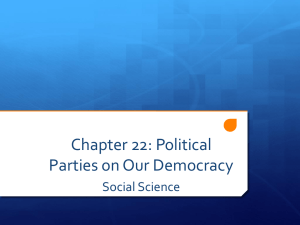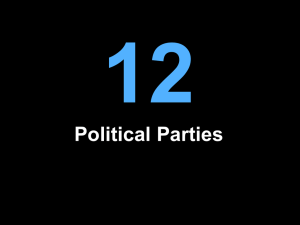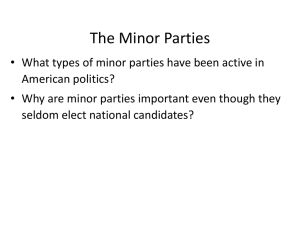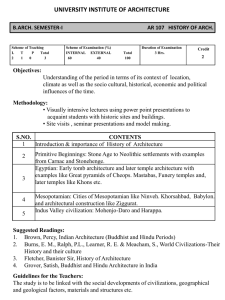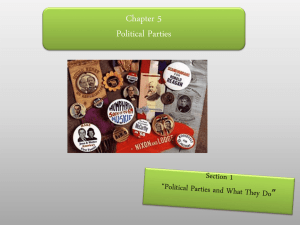Sub-question (b)
advertisement
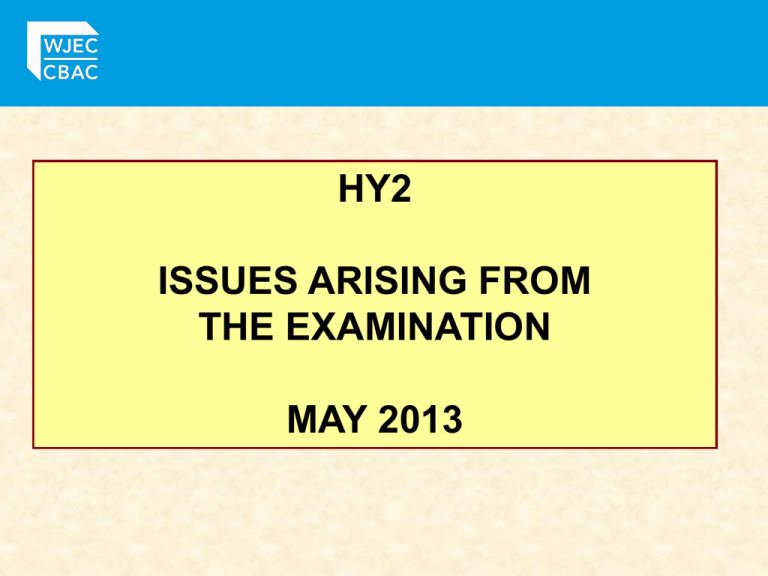
HY2 ISSUES ARISING FROM THE EXAMINATION MAY 2013 HY2 ISSUES FROM THE 2013 EXAMINATION The specification, the revised specimen assessment materials and the Examiner’s Report are available on the history pages of the WJEC website at www.wjec.co.uk HY2 ISSUES FROM THE 2013 EXAMINATION In addition, the WJEC secure website contains examination review material for HY2 including candidates’ scripts and examiner comments on the selected scripts. HY2 ISSUES FROM THE 2013 EXAMINATION The new style of examination of HY2 was creditably attempted by the majority of candidates with evidence, in the better responses, of candidates being very knowledgeable and able to use their history evaluation skills to engage meaningfully with the key issues and the presented evidential material in relation to the questions set. HY2 ISSUES FROM THE 2013 EXAMINATION Although there were many responses which offered valid source evaluation comments it must also be mentioned that, as in the older HY2 examination, there is room for improvement in developing meaningful source evaluation responses in context. HY2 ISSUES FROM THE 2013 EXAMINATION The Examiners, in general terms, felt that where there was a weakness it was because many candidates relied too heavily on formulaic, mechanistic consideration of the content of the sources without engaging meaningfully with the issues outlined in the attributions. HY2 ISSUES FROM THE 2013 EXAMINATION The Examiners also felt that where there was a weakness it was because many candidates were unable to develop responses setting the sources in the context of when they were produced and in the context of the set enquiry, the question set. HY2 ISSUES FROM THE 2013 EXAMINATION The Examiners were also disappointed that many candidates relied too heavily on narrative accounts featuring either copying or comprehension of the sources (or displays of own knowledge) rather than focussing on the source evaluation comments which this paper demands. HY2 ISSUES FROM THE 2013 EXAMINATION One issue which affected a minority of candidates was the timing of the responses. Most of the candidates were able to offer full answers to all four of the sub – questions but some candidates did not address all questions thoroughly. This was mainly because they spent too much time on the first two subquestions. HY2 ISSUES FROM THE 2013 EXAMINATION Where there were concerns on specific papers about one or more of the four sub – questions the Principal Examiners have highlighted such issues in the Examiner’s Report from which the extracts in red, that follow, have been taken. HY2 ISSUES FROM THE 2013 EXAMINATION Sub-question (a) expects definition of an historical term or phrase which is used in one of the sources. This question requires that candidates provide an explanation set in the historical context in which it was produced. Candidates will therefore need to make use of the attribution of the source to understand what the author meant by the term / phrase in the context in which it was produced. HY2 ISSUES FROM THE 2013 EXAMINATION Sub-question (a): candidates should explain, in its historical context, a term or phrase used by an author. The Examiner’s were concerned that some candidates were content to explain what they thought the author meant by the selected phrase just by reference to the content of the source and using their own knowledge. That type of response will fail to gain a Level 2 mark. HY2 ISSUES FROM THE 2013 EXAMINATION Candidates should be encouraged to discuss why a particular author at a particular moment of time would use a certain phrase. To prevent poisonous false doctrine and bad examples from being spread all over Christendom, and so that the art of printing books might be used only towards good ends, we, after mature and long deliberations, order and command by this edict that henceforth, under penalty of confiscation of goods and property, no book dealer, printer, or anybody else mention the Holy Scriptures or their interpretation without having first received the consent of the clerk of the city and the consent of the Faculty of Theology of the University, which will approve those books and writings with their seal. [An extract from The Edict of Worms, published by Emperor Charles V in 1521] (a) What does the author of Source A mean by the phrase ‘poisonous false doctrine and bad examples’? [8] In your answer you are advised to discuss the content and authorship of the source and to use your own knowledge. HY2 ISSUES FROM THE 2013 EXAMINATION That will usually mean being able to understand what was happening at the time, the context in which the source was produced, and the purpose / audience of the author – which demands a focus on the attribution. [An extract from The Edict of Worms, published by Emperor Charles V in 1521] HY2 ISSUES FROM THE 2013 EXAMINATION Mere copying / comprehension of the content or the attribution will not be well rewarded: the date, origin and purpose of the source in context has to be the focus of the candidate’s response. As one of the Principal Examiners commented: HY2 ISSUES FROM THE 2013 EXAMINATION [Some candidates were…] able to explain that ‘the people under the ancien régime’ refers to the unjust tax system which exempted the privileged First and Second Estates from direct taxation leaving the burden to fall on the Third Estate. Fewer candidates were able to explain that the caption accompanied a satirical print drawn by a radical in the year of the Revolution to advocate social and political reform. [A contemporary radical print showing the people of the Third Estate bearing the financial burden of taxation during the ancien regime. The caption translates as ‘The people under the ancien regime’ (c. 1789] HY2 ISSUES FROM THE 2013 EXAMINATION Sub-question (b) expects explanation of the importance or significance of an historical event or development. Candidates will need to analyse and evaluate the content and authorship of the two named sources and also use their own knowledge in their answer to this question. The candidates will need to focus on the attributions of the sources and undertake to provide a full explanation of the importance or of the significance of the named issue in relation to the historical enquiry set. HY2 ISSUES FROM THE 2013 EXAMINATION Sub-question (b): candidates should consider and come to a judgment on the importance or significance of an historical development using the two sources provided and their own knowledge. The Examiners noted that a few candidates were unable to develop fuller responses using the sources in context and many did not focus on the exact question set especially on the key concept of the “significance” or “importance” of the event set. For example: HY2 ISSUES FROM THE 2013 EXAMINATION Source A The Uxbridge Peace Propositions of 1644 included a radical set of proposals for the reform of the Anglican Church. It advocated the abolition of bishops and the Book of Common Prayer and the issuing of a Directory of Worship based on Presbyterian ideas. It was too radical for the King, who rejected it out of hand, thus ending any hopes of a negotiated end to the Civil War. [M. Walzer, an academic historian and specialist in seventeenth-century English radicalism, writing in a specialist textbook, The Revolution of the Saints (1965)] Source B It is a truth conceived by God that all men are created equal and that Englishmen are naturally free. That state of freedom extends to free speech, fair trial and equitable justice, and the right to vote in parliamentary elections for all men over the age of 21. No one man should have the power of life and death over another. [John Lilburne, a parliamentary soldier and leader of the radical Leveller Movement, writing in a political pamphlet, England’s Birthright Justified (1645)] (b) How significant were radical groups in the development of the Civil War? [16] Explain your answer analysing and evaluating the content and authorship of Sources A and B and using your own knowledge. HY2 ISSUES FROM THE 2013 EXAMINATION A few candidates were content to discuss the specific set issue simply in terms of what they knew of the period which is not sufficient for Level 2 marks. Some tried to justify their judgement by copying supporting extracts from the sources which, at best, would gain less than half marks. The Examiners noted that there was a tendency amongst a minority to ignore the sources and focus on the “events” with narrative accounts of what happened. One examiner commented: Most candidates were able to use the content of the sources to explain something about regional unemployment in Britain. Too many did this in a mechanistic way, giving too little focus on what the sources had to say about ‘the significance of regional unemployment. Too many responses were trawling the content and then mechanically discussing the authorship. Needless to say failure to focus the source evaluation comments on the attributions of the sources will restrict such responses to low marks at Level 1. HY2 ISSUES FROM THE 2013 EXAMINATION Candidates should be encouraged to analyse the content and authorship of the two named sources and also use their own knowledge in their answer to this question. That will usually mean being able to focus on the attributions of the sources and undertake to evaluate the importance / significance of the named issue in relation to the particular historical enquiry set. One of the Examiners makes this point (see sources on next slide): Candidates must use the content, attribution and context of the sources to reach a judgement on the importance of the Kansas-Nebraska bill. It is also expected that candidates will use their own knowledge of the period to demonstrate understanding of the importance of this bill. The sources reveal Senator Douglas’s ill-judged attempt to provide a solution to the vexed problems of slavery on the new territories. The Kansas-Nebraska bill heightened sectional tensions, providing evidence of an early civil war in miniature in Kansas. Source A is an exercise in self-justification by the main protagonist of the bill whereas Source B is an impassioned anti-slavery poster. HY2 ISSUES FROM THE 2013 EXAMINATION Source A The bill provides, in words as specific as our language affords, that the act is NOT to legislate slavery into any Territory or State. It does not introduce slavery, does not revive it, does not establish it. The great principle of selfgovernment is declared in this bill to be the rule of action as a final settlement of the slavery agitation. [Senator Stephen Douglas, explaining the aim of his Kansas-Nebraska bill, in a letter to the editor of a newspaper, The Concord Register (16 February 1854)] Source B [An anti-slavery broadsheet advertising a free state convention in Kansas (September 1855)] HY2 ISSUES FROM THE 2013 EXAMINATION Sub-question (c) expects candidates to give a supported and valid judgement on a particular interpretation. They will be expected to use the content and authorship of two nominated sources and their own knowledge to discuss and come to a valid judgement regarding this interpretation. The candidates should be able to bring their knowledge of other interpretations into their answer. HY2 ISSUES FROM THE 2013 EXAMINATION Sub-question (c): candidates should consider and come to a judgment on the validity of a given interpretation in relation to the two selected sources and their own knowledge of other possible interpretations. Examiners noted that the majority of candidates were able to use the nominated sources to discuss the validity of the given interpretation in terms of what the sources had to say – the content of the two sources. HY2 ISSUES FROM THE 2013 EXAMINATION Examiners noted some candidates tried to show how each of the sources may have supported or contradicted the given interpretation. This is what one of the Examiners meant by the report that Candidates needed to focus on how and why different interpretations have been formed. A minority discussed the extent of support or contradiction between the two sources' views, rather than whether they agreed with the interpretation in the question; this tended to limit those candidates to low Level 2. HY2 ISSUES FROM THE 2013 EXAMINATION Some candidates were able to use the attributions to discuss the given interpretation but most were restricted to mechanical comments on reliability or usefulness. A number of candidates failed to develop source evaluation comments based on the attributions provided to the two selected sources in relation to how and why the interpretation may have been formed. This point is made by the Examiner who wrote: HY2 ISSUES FROM THE 2013 EXAMINATION Most candidates were able to use the sources’ content to discuss the interpretation that financial problems were responsible for the outbreak of the French Revolution in 1789. This was linked to their knowledge of the debt crisis caused by military spending and an inefficient tax system. Many candidates hinted at alternative interpretations such as Louis XVI’s weak leadership (as suggested by Source D), the rise of the bourgeoisie or the influence of the Enlightenment. Discussion of the attributions, however, tended to be rather simplistic and mechanical. HY2 ISSUES FROM THE 2013 EXAMINATION Candidates should be encouraged to analyse and evaluate the content and authorship of the two named sources and also use their own knowledge in their answer to this question. That will usually mean being able to use the content and attribution of both sources to provide convincing source evaluation while discussing and coming to a valid judgement on how the issue has been interpreted in different ways rather than just displaying knowledge of the event. The point was made by one Examiner who notes: . HY2 ISSUES FROM THE 2013 EXAMINATION Often the use of additional knowledge to support arguments was impressive although the quality of source evaluation was often disappointing and far less convincing. Sometimes this amounted to little more than mechanistic references to the work of an academic historian who had studied the topic or the diary of a member of the anti-Nazi resistance. Candidates must ensure that through rigorous source evaluation in context that they are able to make a judgement about the validity of the interpretation. HY2 ISSUES FROM THE 2013 EXAMINATION Sub-question (d) expects evaluation of the utility of three nominated sources in the context of the indepth study. Candidates are expected to demonstrate their ability to analyse and evaluate the nominated sources demonstrating source evaluation skills. There should be consideration of issues such as reliability, bias, purpose and validity, as appropriate, when considering the utility of these sources. There should also be consideration of the limitations of the nominated sources in the wider context of the in-depth study. HY2 ISSUES FROM THE 2013 EXAMINATION Sub-question (d): candidates should consider and come to a judgment on the utility of three selected sources in understanding the depth study studied. Some candidates offered responses to this question by commenting on just the content of the three sources (sometimes copying the attributions) and were restricted to low marks as a result. There is really no excuse for comprehension of the sources only at this over-arching question. HY2 ISSUES FROM THE 2013 EXAMINATION Many candidates adopted a formulaic and mechanistic approach of offering comments first on the strengths and then the limitations of the content of the sources followed by a second set of comments on the strengths and limitations of the attributions. HY2 ISSUES FROM THE 2013 EXAMINATION Many, indeed most, candidates adopted another general approach seen was to comment on the strengths and limitations of the three selected sources and then add a short essay on other developments during the period which were omitted from the sources. This approach generally gains about half the available marks. HY2 ISSUES FROM THE 2013 EXAMINATION Many candidates were unable to develop an overall assessment of the sources and to deploy their contextual knowledge and understanding of the whole topic which hindered performance. Too often candidates only evaluated the nominated sources within the context of the limited key issues which are raised within the sources. What is needed is a fuller evaluation of the utility of the three selected sources and clear, contextual reference to the whole topic in an integrated rather than segregated manner. One examiner stressed the point: . HY2 ISSUES FROM THE 2013 EXAMINATION The trend for candidates to persist in dealing with the selected sources in isolation continued into this round of examinations. Candidates must focus upon producing balanced responses to the collection as a whole which meet the demands of the assessment criteria in full in order to access marks at Level 3. HY2 ISSUES FROM THE 2013 EXAMINATION Candidates should be encouraged to analyse and evaluate the content and authorship of the three selected sources in their historical context and also use their own knowledge in their answer to this question. That will usually mean being able to provide convincing source evaluation in the context of their authorship and coming to a valid judgement on their utility. To judge utility, there should be consideration of the content and the authorship of the nominated sources to discuss reliability, bias, purpose and validity, as appropriate. This should be integrated into the developments which took place throughout the depth study. HY2 ISSUES FROM THE 2013 EXAMINATION Candidates at Part (d) should attempt to identify the main characteristic / development in the presented sources (usually there will be three) and use these to consider the relevant context. For example if a source is on “Youth” in Nazi Germany they should be able to discuss the wider theme of social developments set in the context of changes during the Nazi Regime. Another source may give them access to economic issues which they could link to economic and political development over the period. The third source may allow them to focus on opposition which they could link to the organisation of the Nazi state. HY2 ISSUES FROM THE 2013 EXAMINATION Candidates are not expected to simply list all (or as many as they can) of the omissions but they are expected to engage with the content and authorship of the sources in the context of the wider developments during the depth study. They need to use their source evaluation skills to show the strengths and limitations of the three sources in understanding the changing developments in the context of the depth study period.

